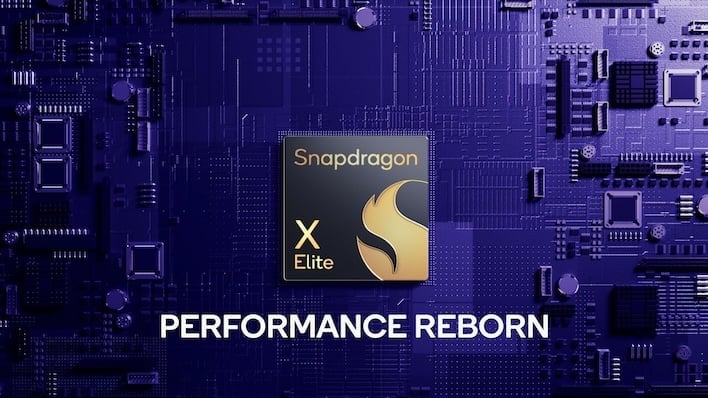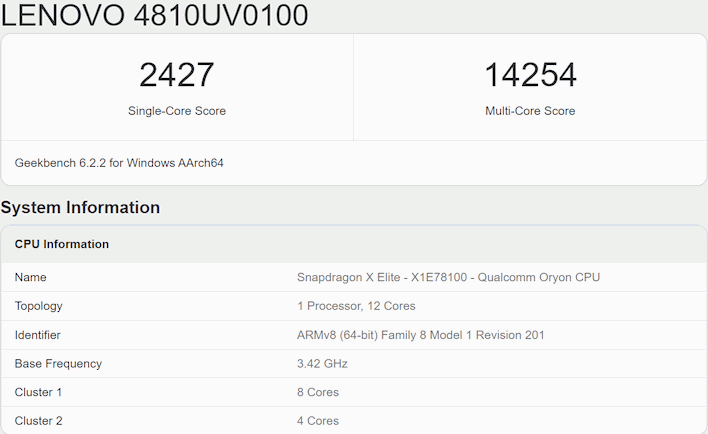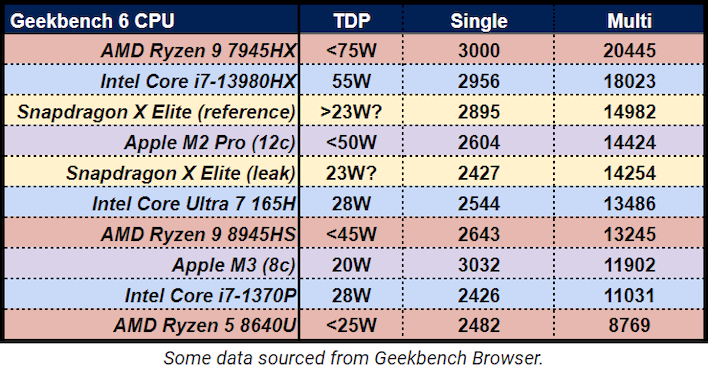
We first wrote about the Snapdragon X Elite back in October of last year, and not long after, we got to take a trip to Qualcomm’s Snapdragon Summit and see the performance of the new processors for ourselves. In short, Snapdragon X Elite appears to offer stunning speed that is truly competitive with some of the best from Apple, AMD, and Intel.

That said, the machines we have been testing are indeed reference platforms and not final products that consumers will be able to buy. In these reference platforms, TDPs and thermals are not necessarily constrained the way they might be in a final shipping product. This is why we’re excited to see this benchmark leak today, which gives us an idea of how the Snapdragon X Elite might perform in a real laptop from Lenovo. Take a peek…

This leak was spotted by @techinamul on Xwitter, who helpfully screenshotted the result in case it was removed. However, Geekbench’s policy is usually to avoid removing results that have already been reported on, so the listing is still up as of press time. The benchmark result appears to be for a Snapdragon X Elite-powered Lenovo machine that may well be a test platform itself given the vague model number, but we expect it’s probably closer to a retail product than Qualcomm’s reference platforms.
Many sites reported that this result demolishes high-end mobile parts from Intel and AMD, but that’s not quite true. Even going by Geekbench’s own official numbers, the single-core result from the leak here loses to a Ryzen 5 8640U, while the multi-core result is just ahead of a variety of 35W-45W Intel and AMD CPUs. We have to stress in both cases that even with its lower TDP, the Snapdragon X Elite is running right in the same pack with these higher-power chips, though.

In fact, it’s shockingly close, which is a fantastic result for Qualcomm, considering that its previous Snapdragon 8cx SoCs have struggled to close the gap with Apple—much less with more power-thirsty x86-64 CPUs. Even better, the Snapdragon X Elite supposedly does this while consuming considerably less power—although we have to note once again that we haven’t gotten to verify that for ourselves.
While some of the breathless enthusiasm surrounding the Snapdragon X Elite is certainly justified, it’s important to remember that these benchmarks are all synthetic and many have been ported to natively support the Arm architecture. Windows does offer solid emulation and most applications will work that way out of the box, but some won’t be fully optimized for Arm. Regardless, Snapdragon X Elite’s performance may be so strong that even under emulation, performance with many applications may exceed Intel or AMD, but this is still an important distinction to make.
Editor’s Update, 7:44 AM 4/5/24 – In fact, if you recall, critics chided Apple’s M1 architecture and Rosetta emulation when it first debuted, and now the industry hardly ever talks about it. With strong enough silicon engines, it seems, if you build it, indeed they will come.

Fortunately, a large portion of what most people do on a PC these days is done in a browser, and Chrome is one application that has already been optimized for these new chips. In fact, the Speedometer result you see above is by far the best we’ve seen on a mobile platform; we’ve only seen a slightly better score (491 runs per minute) on Intel’s flagship desktop CPU, the Core i9-14900K, and that chip can consume nearly 10x the power.
As such, a Snapdragon X Elite device might be an excellent pick, if you’re looking for a highly-portable powerhouse later this year. We’ll be racing to get one reviewed as soon as they’re available, so keep an eye out for that.